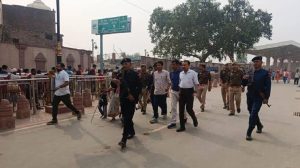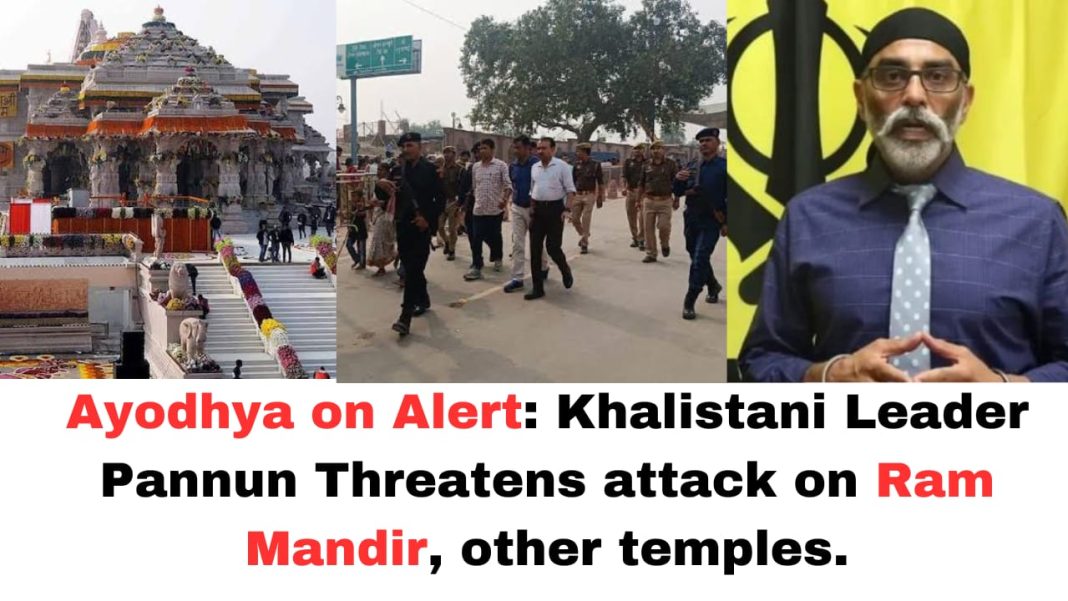Digital News Guru Uttar Pradesh Desk:
Khalistani separatist leader Gurpatwant Singh Pannun, head of the proscribed group Sikhs for Justice (SFJ), has once again come under the spotlight with renewed threats targeting significant religious landmarks in India. The latest warnings, issued through a video, have raised serious concerns among Indian security agencies and religious communities. Pannun’s threats specifically mention the Ram Mandir in Ayodhya, a site that holds deep spiritual significance for millions of Hindus, as well as other religious venues. The attacks are reportedly planned for November 16 and 17, and the language used in his threats seeks to provoke violence and disrupt communal harmony.

Context and Background of the Threats
The Ram Mandir, situated in Ayodhya, has been a focal point of religious and political discourse in India for decades. The temple was opened to the public earlier this year on January 22 in a grand inauguration attended by Prime Minister Narendra Modi and numerous other dignitaries. The temple stands as a symbol of religious resurgence and national pride for many, making it a potent target for those seeking to create turmoil. Gurpatwant Singh Pannun’s declaration to “shake the foundations of Ayodhya” has triggered swift action from Indian law enforcement, which has enhanced security measures across key locations, especially religious and culturally sensitive sites.
The SFJ, which Pannun leads, has been a longstanding advocate for a separate Sikh state, Khalistan, and has persistently conducted anti-India campaigns from its bases abroad, notably in Canada and the United States. Designated as a terrorist by the Indian government in July 2020 under the Unlawful Activities (Prevention) Act (UAPA), Pannun has repeatedly employed inflammatory rhetoric and incitement to violence. His organization has been implicated in numerous efforts to disrupt peace, particularly targeting the Hindu community and the Indian diaspora.
Pannun’s Latest Threat
Pannun’s video, reportedly filmed in Brampton, Canada, outlines a deliberate call for violence. He emphasized attacking the Ram Mandir as well as the broader Hindu religious community, marking November 16 and 17 as dates of action. His speech directly referenced Ayodhya as the birthplace of “violent Hindutva ideology,” aiming to incite division and tension among India’s diverse communities. In the video, he also invoked images of Prime Minister Modi praying at the temple, possibly to inflame political sentiments alongside religious ones.

Pannun’s SFJ is known for leveraging symbolic and provocative dates. This latest announcement comes on the heels of an earlier advisory he issued in October, warning passengers to avoid Air India flights between November 1 and 19, commemorating the 40th anniversary of the 1984 anti-Sikh riots. This tactic aligns with SFJ’s strategy of stirring international concern and seeking to amplify grievances associated with historical events.
International and Domestic Repercussions
The threats have reverberated beyond India’s borders, particularly affecting Indo-Canadian relations. Over the past year, there has been an uptick in incidents involving vandalism and threats directed at Hindu temples in Canada. In Brampton, protests and disruptions by pro-Khalistani elements have caused significant alarm among the Indian expatriate community. Canadian Prime Minister Justin Trudeau, already under scrutiny for his handling of the India-Canada diplomatic crisis, recently condemned violence targeting Hindu institutions in Canada. However, India has been critical of the Canadian government’s perceived inaction, pushing for stronger countermeasures against radical elements.
Domestically, Indian authorities have launched an intensive security review. The Uttar Pradesh state government, overseeing Ayodhya, has coordinated with national intelligence agencies to bolster protective measures around the Ram Mandir and other religious sites. Additional police deployments and high-tech surveillance are now being mobilized to ensure that any attempt at violence is promptly thwarted.
Historical and Political Dimensions
The SFJ’s demands for Khalistan and Pannun’s provocations are part of a broader, decades-old separatist movement that saw its peak in the 1980s and early 1990s. Following the 1984 assassination of Prime Minister Indira Gandhi by her Sikh bodyguards and the subsequent anti-Sikh riots, tensions between segments of the Sikh community and the Indian government deepened. Pannun and his group have since attempted to internationalize their cause, leveraging diaspora networks and social media to spread their message.
The ongoing friction between India and Canada over Khalistani activities has compounded matters. The Indian government has raised concerns about the safety of its diaspora and diplomatic missions in Canada, while Canadian officials have defended freedom of expression and assembly, albeit with condemnation of violence. This diplomatic tension reached a boiling point earlier in 2024, following incidents of vandalism at Hindu temples and clashes between pro-India and pro-Khalistani groups.
Community and Religious Responses
Hindu religious leaders and organizations have condemned the threats, urging followers to remain calm but vigilant. They have appealed for peace and unity, emphasizing that violence only serves to destabilize society. In parallel, Sikh community leaders, many of whom do not support the Khalistani agenda, have also called for communal harmony and denounced the divisive tactics used by Pannun and his allies.

The Way Forward
The Indian government is closely monitoring developments and has reiterated its commitment to safeguarding religious freedoms and ensuring public safety. The incident serves as a reminder of the enduring challenges posed by radical elements seeking to exploit religious and ethnic fault lines. While Indian authorities have ramped up security, the challenge remains formidable given the international dimensions of the threat.
As the dates mentioned in Pannun’s threats approach, the situation continues to evolve. India’s diplomatic channels remain engaged with global partners, particularly in North America, to ensure that efforts to curb extremism are comprehensive and effective.
The latest threats by Pannun are not just an isolated attempt at incitement but rather part of a calculated campaign that seeks to reignite separatist sentiments. The focus now shifts to how effectively Indian and international agencies can work together to prevent violence and foster a sense of security among all communities.
You May Also Read: Mau, Uttar Pradesh: Bike Collision Sparks Violent, Police Injured in Chaos








